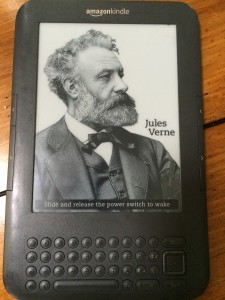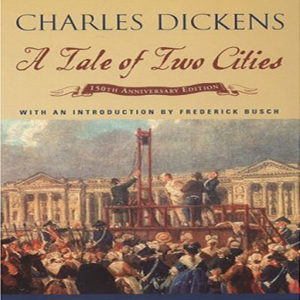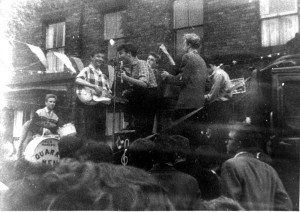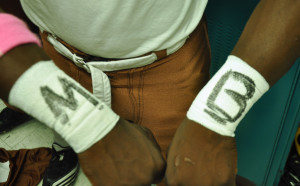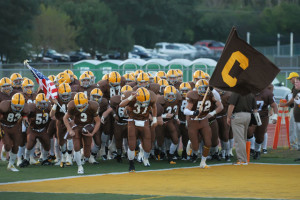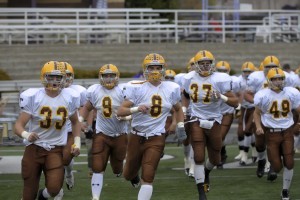Jon J. Kerr's Blog, page 5
August 24, 2015
Boys in Brown Blog: Kindle Version Now Available For Pre-Order
As the release of the non-fiction book The Boys in Brown approaches, author Jon J. Kerr takes readers inside the process. On Tuesdays, the series Brown Beginnings gives readers a behind-the-scenes look at the conception and reporting of the story. Thursdays, he blogs about the writing and publishing steps before launch.
Six years ago this month, I bought my first Kindle. The first book I downloaded was Hammer of the Gods, writer Stephen Davis’s wildly entertaining book on one of my favorite rock bands of all time, Led Zeppelin.
Some 282 downloaded items later, I have the same Kindle today. If you are like me and own one of these digital beauties, I have a book recommendation for you.
For those of you interested in pre-ordering my book, The Boys in Brown, it is now available for pre-order. Just go to this link:
To be clear–the book won’t be delivered to your device until Sept. 1. This is the official release date. But for my loyal subscribers, I wanted to give you the opportunity to order first, before the general public, if you so choose. I can’t thank you enough for your support and loyalty throughout this project.
I will have news Thursday (Aug. 27) on the paperback release.
Feel free to share the news by clicking one of the share buttons below.
Have a great day everybody.
Jon
Boys in Brown Release Announcement
Hope everyone had a great weekend.
As promised, I have news on release dates:
I’ll see you back here Tuesday.
August 18, 2015
Blog: Brown Beginnings, Issue 9 (Why Scout Teams Matter)
As the release of the non-fiction book The Boys in Brown approaches, author Jon J. Kerr takes readers inside the process. On Tuesdays, the series Brown Beginnings gives readers a behind-the-scenes look at the conception and reporting of the story. Thursdays, he blogs about the writing and publishing steps before launch.
There’s much debate swirling on the internet around the topic of youth sports. HBO’s documentary series “Read Sports” ran a piece last month on the topic. This Instagram post by former NFL player James Harrison was a catalyst for much online discussion.
The topic raises questions. Are we praising our children too much? Are parents too involved? What does this all mean? Our answers to these questions are purely subjective, conclusions neither right or wrong. It all depends on your world view. One thing is certain, it makes for engaging–and often combative–debate. Ah, the internet.
As the Carmel football season wore on in 2010, it became apparent the team possessed uncanny chemistry. I wrote in a previous blog post about the healthy tension around the program. But, as the victories rolled up, there was growing awareness of ownership of roles not obvious to those only watching games on Friday night. These players were not getting press accolades or participation trophies. But within the program, they were valued and often recognized. What I’m talking about is the Scout Team.
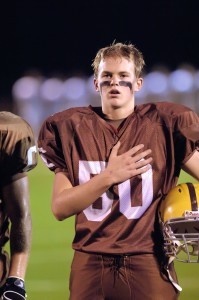
Photo Credit: Steve Lester
By the week of the first game, team roles were clearly established. The starters started, the back ups backed up. By the middle of the season, injuries began to deplete the roster. I remember a practice before the Carmel’s final home game against Notre Dame in week 8 when it dressed 38 players. Coaches had to cut back on specific drills as there weren’t enough bodies to run them. Anytime there are injuries, the circumstance creates an opportunity for second team players to receive a “promotion” to first team. That did happen in 2010 as sophomore Tim Serio stepped in at fullback and junior John Salvi became a starter on defense. And both played well when called upon.
Carmel’s attrition didn’t impact its mastery over opponents. It won eight regular season games that year by an average margin of victory of 30 points. In its first two playoff games, it scored 97 points while allowing 13. Not only did the Corsairs win a lot, they dominated. This often meant second or even third string players, got to play. For them, the chance to perform on a grand stage, in front of thousands of fans, was a reward. But it was not Friday nights, but on Tuesday, Wednesday and Thursday afternoons, on the less-celebratory practice fields, where the scout team’s worth truly shined. Here is a short book excerpt on the team’s routine during the week:
Tuesday and Wednesday of game week are what coach’s call “work days”. Offensive and defensive game plans for Friday’s opponent are installed. Special teams –– punt, punt return, kickoff and kickoff return –– are a major emphasis. Starters get heavy reps. Backup players, also known as the “scout team,” run the opposing team’s plays. The practice session’s final drill –– the Team Drill –– pits both offense vs. defense. It’s all designed to get the boys playing at peak performance by 7:30 Friday night.
Teenagers can be a petulant bunch. They want what they want, when they want it. Delayed gratification is a concept as foreign as VHS tapes or Alicia Silverstone. In sports, participation is the payoff (unless you are the child of James Harrison). But in 2010, up and own the Corsairs’ roster, participation was a matter of perspective. For quarterback Brian Serio, it was taking every first team practice rep and every game snap. For Jim and Eric Hessing, it was making sure they were locked in for every practice snap. They knew they weren’t going to see the field against a Joliet Catholic or Marist if the game was competitive. They were back ups. But their roles–scout team players–was to them, the most important job on the team.
From a pure football perspective, Carmel’s 2010 success has much to do with its scout team, which includes several other seniors. All are most likely playing their last year of organized football, and all are taking hits in practice so the starters can be better prepared on Friday night.
“When we beat Marist, on the car ride home, I was really pumped because if the scout team guys hadn’t been going 100 percent, we wouldn’t have won,” Eric Hessing says.
Chuck Hessing, the boys’ father, said he asked Jim one night about his son’s lack of playing time, about how he felt being on the scout team, most likely to never see the field in a competitive circumstance.
“I said, ‘Do you feel like you are being cheated?’ And he said, ‘Dad, the best players are out there.’”
“Every night at 10:30, Jimmy comes down to tell me everything they have to do to beat the other team,” Sandy Hessing said, their mother. “He’s on MaxPreps and iHigh and figuring out what to do.”
Those late night conversations with her son are often about how he can improve his play, so he can help his teammates.
“What Jim said to me was, ‘I have to get better. [Tight end] Patrick Mulroy is not getting the right grade as I’m not getting him ready for the game,’” Sandy said. ‘”I’ve got to get back to practice and work harder.’”
This acceptance, this curtailment of one’s self-interests, is counterintuitive for most teenagers yet this dynamic is critical to team chemistry.

Photo credit: Steve Lester
Often over the last few years I’ve been asked, ‘why was that team so good? Well, yes, the Corsairs had a lot of talent. And yes, they had great coaching and terrific community support. But the connective tissue binding those foundational pieces were players like Jim and Eric Hessing, Matt Principe, Jake Klahs, Seamus Quilty, Bryan Parrish, Tom Leahy, Paul Madison, Connor Greene, Jeff Schroeder, Garrett Sykora, Mike Reimer, John Krzeminski, Brad Kamins, Mike Kolb, Sean Terrett and J.C. Pawlak. Their willingness to embrace their less-than-glamorous circumstances, and in many cases, transcend it, is that season’s dirty little secret.
August 13, 2015
Blog: Behind the Book, Issue 6
As the release of the non-fiction book The Boys in Brown approaches, author Jon J. Kerr takes readers inside the process. On Tuesdays, the series Brown Beginnings gives readers a behind-the-scenes look at the conception and reporting of the story. Thursdays, he blogs about the writing and publishing steps before launch.
I go back to video blogging today. This is because I have something to tell and show.
A big announcement comes next week. Enjoy your summer weekend!
August 11, 2015
Blog: Brown Beginnings, Issue 8 (The Art of Tension)
As the release of the non-fiction book The Boys in Brown approaches, author Jon J. Kerr takes readers inside the process. On Tuesdays, the series Brown Beginnings gives readers a behind-the-scenes look at the conception and reporting of the story. Thursdays, he blogs about the writing and publishing steps before launch.
At the heart of every good story is tension. In fiction, the best novelists (John Grisham, Tom Clancy) manufacture tension by putting their characters in circumstances where the outcome is uncertain. For a writer, this is easier as moments are as anxious as he or she wants them to be. In non-fiction, tension can’t be forced. It must unfold organically.
As the 201o season rolled on for the Carmel Corsairs, I was in a fortunate circumstance. Because the team starting winning–and kept winning well into October–tension grew from triumph. After each Friday night, the mantra was, ‘let’s do it again!’ The thrill of victory (or the agony felt from any potential defeat) became the elixir consuming the program, driving them each week to repeat each conquering feat.

Credit: Steve Lester
After the Corsairs week 4 win over Joliet Catholic, players, coaches and the community knew the team was good. A win over a rival, especially early in a season, can imbue a team with confidence. The stakes become higher, expectations elevated. This push-pull, the space between reward and urgency, is where tension lies. This is always the best type of tension, when the strain, the stress, is also the thrill. And there was plenty of it around the Carmel football program after week 4.
I first witnessed growing tensity early the following week. Carmel was scheduled to face Marist, another conference opponent. For this game, the Corsairs wouldn’t have the advantage of playing at home. And injuries had started to become an issue. Here is a book excerpt from the week of the Marist game:
Head Coach Andy Bitto gave the team the weekend off after beating Joliet Catholic. It’s a game that will be remembered for a long time, but by Wednesday, the look on Coach Bitto’s face says he’s already forgotten it. Or at least put the memory on ice.
Leaning back on his office chair, he’s back to staring at the small television monitor propped up on a table behind his desk. He’s watching game film for Friday night’s opponent, Marist, and it scares him.
This is a week Coach Bitto and the coaches have dreaded since they saw Joliet Catholic on the schedule. Marist is what football coaches call a “trap game.” This means your team is playing…
1.The following week after an emotional win over a rival team
2.On the road with a longer-than-usual bus ride
3.Immediately after an emotional win over not just a rival but your biggest rival
Mother Nature is contributing to the anxiety. Tuesday’s practice is called off early due to a lightning storm in the area, and the team hasn’t had a full workday since the Wednesday before the Joliet Catholic game. There are a lot of distractions.
“I don’t like the distractions,” Coach Bitto says, who also has a nagging cough. “It makes it difficult with a week like this. Maybe they’ll go out and play like gangbusters, but I’m nervous.”
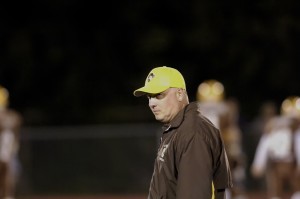
Credit: Steve Lester
Before I walked into Coach Bitto’s office that day, I remember thinking how happy everyone must be after beating Joliet Catholic. But I soon realized basking in the afterglow of success is not a practice of successful programs. Wins only serve as re-ignition fuel, tools for culture validation. Are we doing things the right way? Are we practicing with the right execution and intensity? Friday night’s result provides affirmation, positive or negative. Prosperity is not static, but an elastic force. Those who stop and smell the roses, well, they eventually fall in their vanity-created bed of flowers. And tension, even in flourishing times, is heathy.
That day, Coach Bitto created tension, not by diminishing the Corsairs accomplishments, but through urgency. He and the coaches were hard on the boys all week. There would be no resting on the previous week’s feats. The narrative was instead about what’s next? How can we as a team get better? This is another excerpt from a speech he gave to the boys after practice two days before the Marist game:
At the end of practice, Coach Bitto gathers the team on the stadium field. He has toned down the rhetoric from earlier in the afternoon, but his message is no less stern in its intent. In 48 hours, the Corsairs will play a football game, and they had better be prepared.
“Think about school or at work or TV shows,” he says. “You don’t have to be at the right time or the right place to do it. Teachers will let you make up a test. Your boss may give you a break and let you come in late one day. With TiVO, you know if you miss it, you can watch the Bears game later. When you are playing football it isn’t that way. You have to be ready to play at 7:30 p.m. no matter what. I don’t care if the band is out there naked. I don’t care if the bus is in a traffic jam. I don’t care if you are sick on a Wednesday. You have to be ready to play. Does everybody got that?
“Wish nothing. I can’t caution you enough. Don’t take for granted we had big victories the first four weeks, especially against Joliet Catholic. That doesn’t mean squat now! All we have is one chance. There are no second chances in sports. None.”

Credit: Steve Lester
That Friday night, Carmel would defeat Marist 20-16 in the season’s most thrilling game. The Corsairs remained unbeaten. But what they learned through triumph was how greatness is achieved not through complacency, but through pressure. And how tension–healthy stress–can be a positive force within a program culture.
August 7, 2015
Blog: Behind the Book, Issue 5
As the release of the non-fiction book The Boys in Brown approaches, author Jon J. Kerr takes readers inside the process. On Tuesdays, the series Brown Beginnings gives readers a behind-the-scenes look at the conception and reporting of the story. Thursdays, he blogs about the writing and publishing steps before launch.
“It was the best of times, it was the worst of times…” -Charles Dickens
There is no better time in history to be a writer/publisher. And I say this when revenue declines are the new normal in publishing.
I can only speak from my perspective. If Amazon did not exist, I would not be able to publish The Boys in Brown.
In an earlier Behind the Book post, I wrote about the challenges I had early on in finding a traditional publisher. I decided to press forward with the project anyway. This was due in large part to my strong belief in the story. But believing in something and being able to deliver a product are mutually exclusive. Conviction must be matched by fidelity–in this case, is there a production and distribution model that allows for delivery? Fortunately in 2015, market conditions favor the independent author.
Most of you reading this blog are doing so from your email account. At some point in the last few years or months, you agreed to provide your email address to www.boysinbrown.com. You probably received a free chapter as an incentive to provide the information. This post (and other blog updates) was sent directly to your email address via a permission-based distribution model. This is a way for me the author, to communicate directly to you, the reader. It’s my belief email is the best way to grab readers attention. There is so much noise on the internet that email is the most effective way to diffuse (although not completely extinguish) that noise. You are interested in this project and I want to reward that interest by providing content I hope you will read and share. A win-win.
Sometime next week, I will be announcing launch date information for The Boys in Brown. My team is finalizing details as of this writing. One thing we do know for sure is where you can get a copy. It will be on Amazon.
Why Amazon?
For one, it’s a distribution platform. It allows for my product–the book–to be purchased, printed, then delivered. Amazon allows for me to set the price of the book (more on that next week). It also provides a familiar store front for you, the reader. How many of you have purchased something on Amazon in the last 30 days? How many of you own a Kindle or have the Kindle app on your iPad or iPhone? An educated guess is almost all of you are answering ‘yes’ to one or more of these questions. Bottom line, if you prefer a printed version of the book, Amazon will provide one. If you prefer a digital version, Amazon will provide one. As a writer, I want readers to be able to consume my words from whatever podium they choose. Amazon allows me the ability to do so.
So by first choosing to receive content around the book via permission-based emails, you can consume blog updates on your own time, as often as you’d like, within a comfortable habitat. Next, if you so choose, you will be able to purchase copies of The Boys in Brown via a distribution channel that is not only well-known, but is platform-friendly. The consumer wins, as does the publisher.
For an indy writer such as myself, it is the best of times. And most important, for you the reader, it is truly the best of times.
August 3, 2015
Blog: Brown Beginnings, Issue 7
As the release of the non-fiction book The Boys in Brown approaches, author Jon J. Kerr takes readers inside the process. On Tuesdays, the series Brown Beginnings gives readers a behind-the-scenes look at the conception and reporting of the story. Thursdays, he blogs about the writing and publishing steps before launch.
No athletic season is more climatic than a football season. Its once-a-week dynamic gives each contest a heightened sense of meaning and drama.
During my time with the 2010 Carmel Corsairs, I did not miss a game. Because I attended each practice, meeting and film session, by Friday nights, my emotions mirrored that of the players and coaches. I was excited, anxious, restless and impatient. What I felt was a direct result of the time and energy invested. Relationships were built to a level where it mattered to me how the boys and coaches performed each Friday. And it was Friday nights when all involved in the program saw the fruits of their labor.
In 2010, there were 12 such contests. Nine were played in the regular season, three in the playoffs. As I began to write what became The Boys In Brown, a decision had to be made.
What games do I write about in the manuscript?
The obvious answer is all of them. A book about a football season should include sections about the games, right? Buzz Bissinger, author of the 1990 classic book, Friday Night Lights, once said this about his writing process for FNL:
“Each game had to have meaning beyond the x’s and o’s. It had to tie into a larger theme of the world I was capturing in the book.”
I thought about that as I began to write. If sports is a microcosm of society, how can I apply this idea to Carmel? What cultural threads about this community can be woven within the context of a football game?
The fact the Corsairs did not win the state championship that season allowed flexibility. If they had won the whole thing, I would have to write about each game. In some respects, this would have been easier. The drive to immortality becomes the story. But Carmel lost in the state quarterfinals, to St. Rita. This afforded me some elasticity with the narrative. So of the nine regular season games, I decided to write extensively about four.
Here are the four accompanied by a short excerpt from each section:

Photo Credit: Steve Lester
JOLIET CATHOLIC
The game over, players and students wander over to the north end zone. A circle forms, extending out to the 10-yard line. The celebratory cackling hushes. Fans leaving the stands stop and lean against the railing. On the field, all within the circle clasp hands, then take a knee. In the middle of the circle stand four players –– Michael Fitzgibbons, Jake Larson, Michael Cohen and Paul Madison. Still in uniform, they survey the scene unfolding in front of them. They face the crowd. Fitzgibbons stands furthest to the left. He extends out his left hand. Larson grabs it with his right. Madison clasps his right hand with Larson’s left, Fitzgibbons the same with Madison. They wait for a few lingering students to join the circle. All heads bow.
The stadium lights still glow, canopied below a clear September sky. The scoreboard shines. It reads:
HOME 31, GUEST 28
It’s absurdly silent, as if all humanity were taking a deep breath. The Greeks have a phrase for an occasion such as this.
The supreme moment.
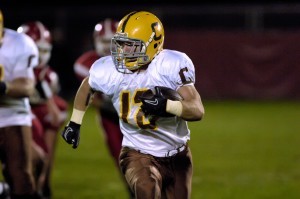
Photo Credit: Steve Lester
MARIST
All through his son’s youth football years, Ed had been his son’s coach. He had the voice to prove it, deep and booming, just what is needed when controlling a herd of adolescent boys. Now, amid the orchestra of ambient noise inside Marist’s stadium, he knows Jordan is getting the ball. For so many years, when he was coaching, he’d seen his son in the same situation run through would-be tacklers. This is what he’s seeing tonight. No juking, just straight-ahead power running. The fan in Ed is mesmerized by the sequence of events taking place. But the father in him makes him stand up from his bleacher seat and yell out to his son:
“Let’s go Jordan! Dig deep! Hold onto the football!”
Like a quivering echo reverberating through a cave, Jordan recognizes the cackle from where his father sits. He turns his facemask in the direction of his father’s motivational aphorisms. He nods.
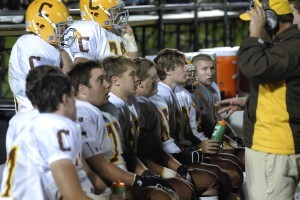
Photo Credit: Steve Lester
MARIAN CATHOLIC
Several minutes later, Wolfy is helped off the field, unable to put any weight on his left leg. Once on the sidelines, he is propped up on the trainer’s table behind the Carmel bench, the injured leg wrapped with ice. Thinking the leg might be broken, Henrichs attaches a splint for the trip home. If so, Wolfy’s football career at Carmel is most likely over.
The development curbs the joyfulness of the 24-0 victory but not its meaning: The Corsairs have clinched a share of the conference championship.
Wolfy’s head rests on the table, both hands at his side, his legs stretched out, one encased in ice. He is motionless, staring upward into a cloudless sky.
Michael Cohen is the first to approach him. Cohen grabs Wolfy’s right hand. Kos limps over and grabs his left. Wolfy moves his head from side-to-side, staring up at Cohen and Kos, their expressions a mixture of intensity and compassion. Within seconds, all of Wolfy’s teammates, coaches and trainers, surround him, hands locked. Coach Ben Berg breaks the silence.
“Our Father, who art in heaven …”
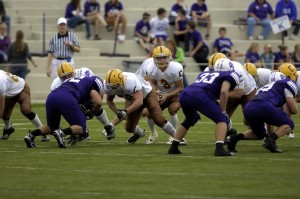
Photo Credit: Steve Lester
ELDER
The purple jersey and pants of the home team provide a startling contrast to Carmel’s brown (pants) and white (jersey). Boosting the inverse chromaticity are the fans. They are decked out in mulberry-stained tops and bottoms (mostly shorts as its a warmer than usual October day), reflecting the school colors. Fans fill out most of the rows behind the home bench. But the atmosphere is detached, complacent. More appropriate for a Yanni concert in the park than a football game. Elder is having an uncharacteristically poor season, losing five of its seven games. That could be the reason for the purple placidity. Or maybe nervousness over the unfamiliarity with these option-running boys from Illinois.
On the other side of The Pit, the visiting stands are peppered in brown and gold. Scott and Beth Carr, parents of the injured senior Matt Carr, along with Bruce and Diane Cappis, parents of running back Ryan Cappis, rented an RV, drove into Cincinnati, and parked the vehicle in the stadium lot. Brian and Tim Serio’s older brother Mike, a running back on the 2003 championship team, flew in from New York to watch his little brothers play. Coach Bitto’s elocution about bringing Carmel’s tradition to Ohio is anything but hyperbole.
Of the three postseason games, the St. Rita game is most written about.
No sport allows a writer as sweeping a canvas as football. All of a community’s bone marrow agglomerates in one location. And while the result matters, in The Boys in Brown, it’s the relationship between the sport, participants and support populace that is most tantamount to telling a truthful story.
July 31, 2015
Blog: Behind the Book, The Writer’s Workplace
As the release of the non-fiction book The Boys in Brown approaches, author Jon J. Kerr takes readers inside the process. On Tuesdays, the series Brown Beginnings gives readers a behind-the-scenes look at the conception and reporting of the story. Thursdays, he blogs about the writing and publishing steps before launch.
For this issue of Behind the Book, you get words and a face.
I thought I’d video blog for this issue. The idea is to give you a brief behind-the-curtain tour of my home work surroundings. Nothing fancy–I shot the three-minute video with an iPhone 5.
OK, above is not actually my work station. Play the link below. Watch the video. Hope you enjoy it. Have a great weekend.
July 27, 2015
Blog: Brown Beginnings, Issue 6
As the release of the non-fiction book The Boys in Brown approaches, author Jon J. Kerr takes readers inside the process. On Tuesdays, the series Brown Beginnings gives readers a behind-the-scenes look at the conception and reporting of the story. Thursdays, he blogs about the writing and publishing steps before launch.
On July 6, 1957, an English rock band named the Quarrymen finished a concert behind a Liverpool church named St. Peter’s.
After the gig, the lead singer of the Quarrymen, John Lennon, was introduced to an aspiring musician named Paul McCartney.
A few years later, the two teenagers formed a band called The Beatles. In 1966, The Beatles recorded a song titled “Eleanor Rigby.”
In a cemetery near the same church where Lennon and McCartney met almost 60 years ago, rests a gravestone. On that gravestone is carved the name Eleanor Rigby.

Credit: Sue Adair
Although Lennon and McCartney never directly attributed the inspiration for the song to the deceased Rigby, the coincidence is striking. Musicians often say how the subconscious influences their writing. It’s not a stretch to assume this landmark in a Liverpool cemetery provided a creative spark that led to one of the most famous Beatles songs in history.
I had a similar experience while reporting and writing The Boys in Brown.
Early in that season, 2010, I attended a Thursday night team dinner. The meal was hosted at the home of Luke Venegoni, a senior linebacker for the Corsairs. I had a good conversation that night with Luke’s mom, Claudia. On the way out, I noticed a picture frame containing a newspaper article on the inside. This is a brief excerpt from the book describing that moment:
She puts the picture book away. On a mantel in the front hallway is a picture frame, which contains a newspaper article. It’s a story on linebacker LaRon Biere. Claudia cut the article out and had it framed. She says she plans to give it to LaRon next time she’s at school. Which is in less than 24 hours.
In the article, LaRon talked about his adopted mother, Marion Biere. She had passed away earlier that year and LaRon had dedicated the football season to her.
I took note of what he revealed, and like so many anecdotes, filed it away as a “look into more later” story. It entered my subconscious.
In an earlier blog post, I wrote about how the first book draft featured the Carmel coaches as the main characters. An early editor, Peter Meyer, was the first to ask if there was more story to tell. His question jolted my subconscious. This was late summer of 2012. What I first learned of almost two years prior came crashing back into present time.
What about Marion? Who was she? Why did she do what she did?
Finding answers to those questions took me in a different direction with the project. I went from having what I thought was a finished book about a group of immensely loyal high school coaches to pivoting towards profiling a now deceased but while alive, a seemingly ordinary nurse and housewife from Ingleside, IL. Yeah, good luck making that interesting.
As a writer, all we really have is our curiosity. The ability to make something interesting out of the obtuse. A writer enters a place and, through his or her prism, brings a reader in. Think of Charles Dickens’ London. Or Alice Walker’s vision of a prejudiced rural south during the Great Depression. We might have our own ideas as to the sight, smell and sound of these locales. But what we want is the author’s version of that place. When a writer’s voice aligns with a reader’s imagination, magic happens. This is true with A Tale of Two Cities and The Color Purple.
As I researched Marion’s life, interviewed people who knew her, I became increasingly convinced that I needed to take readers into her world, to a different time and place. And by doing so, I could tell a more complex story, one not just about a sport, but about society and culture. Here’s another excerpt from The Boys in Brown, when a high school-aged Marion is exposed to racial inequality for the first time:
In 1947, Holy Child High School was still all white. The cultural belief at the time was that blacks were not on equal footing with whites. One year while Marion was at Holy Child, an incident mirrored this widely held discriminatory view. An African-American doctor, Dr. Smith, who lived in neighboring North Chicago, would see patients at St. Therese’s, a hospital founded in 1929 by the Servants of the Holy Spirit missionary sisters. Well-respected as a doctor and community leader, Smith had a daughter. As Aloys Wegener wanted for his daughters, Marion and Joanne, Dr. Smith desired a Catholic education for his daughter. But Holy Child wouldn’t accept her. Administrators came to the conclusion that accepting a black student would become a financial liability as the result of students leaving en mass, not wanting to share the same classroom as a colored girl. The school said it could not afford the risk.
When Marion found out, she told Joanne and her parents how unjust this decision was. How could they keep someone from experiencing the same education as her just because she was black? It simply wasn’t fair.
And at that moment, Marion vowed if she were ever in a position to right this wrong, she would.
Adding Marion’s story to The Boys in Brown was not obvious at first. But by mining the subconscious, and trusting my instincts, the book transformed into something more fully-formed. And as I began my second draft, it felt right. I can only imagine if John and Paul felt the same way while penning Eleanor Rigby all those decades ago.
July 20, 2015
Blog: Brown Beginnings, Issue 5
As the release of the non-fiction book The Boys in Brown approaches, author Jon J. Kerr takes readers inside the process. On Tuesdays, the series Brown Beginnings gives readers a behind-the-scenes look at the conception and reporting of the story. Thursdays, he blogs about the writing and publishing steps before launch.
This past weekend, I finished reading The Wright Brothers, David McCullough’s terrific biography of the founders of modern flight, Wilbur and Orville Wright.
The story of the Wrights is remarkable–at the turn of the 20th century, two seemingly ordinary bicycle shop salesman from Dayton, Ohio designed, built and flew the first “flying machine.” Much of the engineering first crafted by the Wrights 100 years ago is still used in modern aircraft today.
What struck me most about the Wrights was their personalities, bizzarely eccentric and unflaggingly industrious. Both were peculiar men, never marrying, living with their sister and father for much of their lives. They were intellectually curious; starting an alternative weekly magazine in Dayton and while in Europe selling their “flying machine,” spent days wandering the streets of Paris, studying the city’s grand architecture. Their journey from inception to recognition was long and arduous, yet McCollough writes the two “never complained, were always kind and polite to the public and to each other.”
So its safe to say Wilbur and Orville were nice guys who did extraordinary things. Their quirkiness is what made them great.
By week 2 of the 2010 football season, I knew the same of the Carmel Corsairs.
This was the Libertyville game. Carmel had destroyed St. Charles East in week 1, 55-7. It was obvious in that game the team had skill position talent. The Corsairs had a speedy tailback in Michael Panico and a tough, bulldozer of a fullback in Jordan Kos. They also had a cerebral decision maker at quarterback, Brian Serio. Head coach Andy Bitto told me he preferred quarterbacks “be vocal. It’s hard to play that position without being a vocal leader.” But being forceful with his mouth was counterintuitive for Serio. He was a bookishly analytical young man (who graduated this spring from Purdue University with a degree in mechanical engineering), preferring to let his execution do the talking. Kos possessed a sarcastic wit to go with a bombastic running style. Panico was a flaky, goofy kid who ran with cheetah-like acceleration and wore his hair long enough (by private school standards) to earn being compared to a pop culture star of that year:
Panico is as indifferent to Carmel’s rule on hair length (cut above the ears) as he is to oncoming tacklers. This is why Coach Bitto has begun referring to his star running back as Justin Bieber, the teen idol with the mop-top.
It’s catching on.
“Hey, Justin!” yell a few of the players in unison.
Before he begins calisthenics, Panico quickly pulls his head back, giving his just-above-the-ears shag a slight flip in mock affirmation. A few teammates laugh. A slight grin crosses his lips. He wants everyone to know he’s in on the joke.
The defense had its share of rational misfits as well. Safety Mike Fitzgibbons, the son of defensive line coach and long time head coach Michael Fitzgibbons, preferred to wear pink socks to Thursday practices. To his father, who due to working three jobs that fall had packed on a few extra pounds, he would say, “when is the baby due?” Defensive end Michael Cohen often ignored practice instruction and went right for the quarterback. Linebacker Luke Venegoni was much like Serio–studious, almost meditative, in persona.
Here’s what they had in common–they were all unshakably nice young men. And when they played football together, these collection of personalities produced exceptional results.
There was a moment in the Libertyville game when it was apparent to everyone the 2010 Corsairs were special:
With 6:12 remaining in the third quarter, Carmel takes over on its 20-yard line. All game, the Corsairs have moved the ball on the ground with their triple-headed attack of Serio, fullback Jordan Kos, and running back Michael Panico, who had a 74-yard touchdown run earlier in the quarter. On this drive’s first snap from center, Serio moves one step to his right, then jams the ball into the belly of Kos. But he pulls it back, cradling it with both hands and sprinting into an open alley on the right side. Twenty-eight yards later he’s finally dragged down. Four plays later they score a touchdown to make it 34-27.
On the ensuing possession, Libertyville takes over on its 16-yard line. On the first play, Schurr is hit hard behind the line of scrimmage by defensive end Jake Larson. The ball is jarred loose and rolls into the end zone, and linebacker LaRon Biere falls on it for another Carmel touchdown. That’s two scores in 11 seconds, and what had been a close game is now a 41-27 Carmel lead.
Just as Coach Bitto stressed pre-game, the Corsairs are playing with emotion. But they are the more composed team, repurposing the crowd’s heightened energy into robust on-field execution.
On the road, against a local rival, Carmel took control of a game that at one point, appeared to swing in favor of the Wildcats. This was a team of differing personalities; some eccentric, some normal, some rebellious. But what was certain about the 2010 Corsairs late that Friday night of September 3, 2010, was that this collection of nice guys was a damn good football team.

